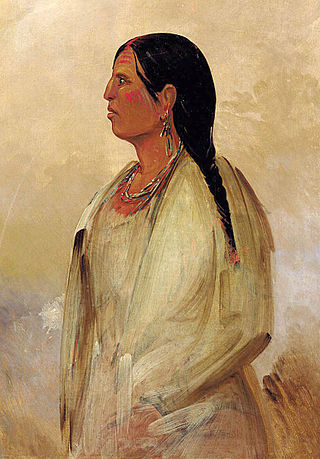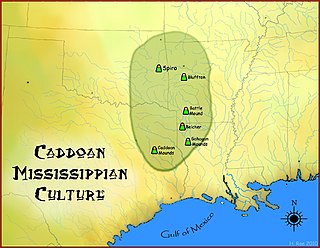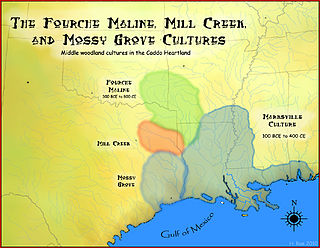
In archaeological terminology, a projectile point is an object that was hafted to a weapon that was capable of being thrown or projected, such as a javelin, dart, or arrow. They are thus different from weapons presumed to have been kept in the hand, such as knives, spears, axes, hammers, and maces.

Clovis points are the characteristically fluted projectile points associated with the New World Clovis culture, a prehistoric Paleo-American culture. They are present in dense concentrations across much of North America and they are largely restricted to the north of South America. There are slight differences in points found in the Eastern United States bringing them to sometimes be called "Clovis-like". Clovis points date to the Early Paleoindian period, with all known points dating from roughly 13,400–12,700 years ago. As an example, Clovis remains at the Murry Springs Site date to around 12,900 calendar years ago. Clovis fluted points are named after the city of Clovis, New Mexico, where examples were first found in 1929 by Ridgely Whiteman.

Indigenous peoples of the Southeastern Woodlands, Southeastern cultures, or Southeast Indians are an ethnographic classification for Native Americans who have traditionally inhabited the area now part of the Southeastern United States and the northeastern border of Mexico, that share common cultural traits. This classification is a part of the Eastern Woodlands. The concept of a southeastern cultural region was developed by anthropologists, beginning with Otis Mason and Franz Boas in 1887. The boundaries of the region are defined more by shared cultural traits than by geographic distinctions. Because the cultures gradually instead of abruptly shift into Plains, Prairie, or Northeastern Woodlands cultures, scholars do not always agree on the exact limits of the Southeastern Woodland culture region. Shawnee, Powhatan, Waco, Tawakoni, Tonkawa, Karankawa, Quapaw, and Mosopelea are usually seen as marginally southeastern and their traditional lands represent the borders of the cultural region.
Gregory Herman Perino was an American self-taught professional archaeologist, author, consultant, and the last living founder of the Illinois State Archaeological Society. Perino was considered one of the foremost experts on Native American artifacts. He died July 4, 2005, at the age of 91.
A Cascade point is a projectile point associated with the Cascade phase, an ancient culture of Native Americans that settled in the Pacific Northwest that existed from 9000 or 10000 BC until about 5500 BC.
The Prehistory of West Virginia spans ancient times until the arrival of Europeans in the early 17th century. Hunters ventured into West Virginia's mountain valleys and made temporary camp villages since the Archaic period in the Americas. Many ancient human-made earthen mounds from various mound builder cultures survive, especially in the areas of Moundsville, South Charleston, and Romney. The artifacts uncovered in these areas give evidence of a village society with a tribal trade system culture that included limited cold worked copper. As of 2009, over 12,500 archaeological sites have been documented in West Virginia.

The archaeology of Iowa is the study of the buried remains of human culture within the U.S. state of Iowa from the earliest prehistoric through the late historic periods. When the American Indians first arrived in what is now Iowa more than 13,000 years ago, they were hunters and gatherers living in a Pleistocene glacial landscape. By the time European explorers visited Iowa, American Indians were largely settled farmers with complex economic, social, and political systems. This transformation happened gradually. During the Archaic period American Indians adapted to local environments and ecosystems, slowly becoming more sedentary as populations increased. More than 3,000 years ago, during the Late Archaic period, American Indians in Iowa began utilizing domesticated plants. The subsequent Woodland period saw an increase on the reliance on agriculture and social complexity, with increased use of mounds, ceramics, and specialized subsistence. During the Late Prehistoric period increased use of maize and social changes led to social flourishing and nucleated settlements. The arrival of European trade goods and diseases in the Protohistoric period led to dramatic population shifts and economic and social upheaval, with the arrival of new tribes and early European explorers and traders. During the Historical period European traders and American Indians in Iowa gave way to American settlers and Iowa was transformed into an agricultural state.

The Upper Mississippian cultures were located in the Upper Mississippi basin and Great Lakes region of the American Midwest. They were in existence from approximately A.D. 1000 until the Protohistoric and early Historic periods.

The Baytown culture was a Pre-Columbian Native American culture that existed from 300 to 700 CE in the lower Mississippi River Valley, consisting of sites in eastern Arkansas, western Tennessee, Louisiana, and western Mississippi. The Baytown Site on the White River in Monroe County, Arkansas is the type site for culture. It was a Baytown Period culture during the Late Woodland period. It was contemporaneous with the Coastal Troyville and Troyville cultures of Louisiana and Mississippi and the Fourche Maline culture and was succeeded by the Plum Bayou culture. Where the Baytown peoples built dispersed settlements, the Troyville people instead continued building major earthwork centers.

The Bare Island projectile point is a stone projectile point of prehistoric indigenous peoples of North America. It was named by Fred Kinsey in 1959 for examples recovered at the Kent-Halley site on Bare Island in Pennsylvania.

The Caddoan Mississippian culture was a prehistoric Native American culture considered by archaeologists as a variant of the Mississippian culture. The Caddoan Mississippians covered a large territory, including what is now Eastern Oklahoma, Western Arkansas, Northeast Texas, Southwest Missouri and Northwest Louisiana of the United States.

The Fourche Maline culture was a Woodland Period Native American culture that existed from 300 BCE to 800 CE, in what are now defined as southeastern Oklahoma, southwestern Arkansas, northwestern Louisiana, and northeastern Texas. They are considered to be one of the main ancestral groups of the Caddoan Mississippian culture, along with the contemporaneous Mill Creek culture of eastern Texas. This culture was named for the Fourche Maline Creek, a tributary of the Poteau River. Their modern descendants are the Caddo Nation of Oklahoma.

In the classification of Archaeological cultures of North America, the term Plainview points refer to Paleoindian projectile points dated between 10,000 and 9,000 Before Present. The point was named in 1947 after the discovery of a large cache of unfluted, lanceolate spear tips with concave bases that were found in a Bison antiquus kill site along the Running Water Draw river, near the town of Plainview in Texas, United States. The point is found primarily throughout the South Plains, however, this range may sometimes be misidentified, as "Plainview" was previously used as a general term to describe unfluted lanceolate points throughout the entirety of the Plains, as well as the eastern Upper Mississippi Valley.

The Younge site is an archeological site located in Goodland Township, Lapeer County, Michigan. It is classified as a prehistoric Late Woodland site and was designated as a Michigan State Historic Site on October 29, 1971. It was added to the National Register of Historic Places on October 29, 1976.

The Juntunen site, also known as 20MK1, is a stratified prehistoric Late Woodland fishing village located on the western tip of Bois Blanc Island. It was listed on the National Register of Historic Places in 1978.
The Clampitt site (12Lr329) is a prehistoric archaeological site that sits on a sandy terrace along the East Fork of White River, southeast of Bedford in Lawrence County, Indiana. The site was excavated by the Indiana University archaeological field school in the summers of 1991 and 1992. The Clampitt site was added to the National Register of Historic Places in 2016. The site is located on private property. It is one of thirteen National Register of Historic Places listings in Lawrence County, Indiana.
The Schwerdt site (20AE127) is located on the Kalamazoo River in Allegan County, Michigan. It is classified as a single-component Berrien phase site dating to the late prehistoric period. The Berrien phase is associated with the late Woodland but also has some Upper Mississippian influences.
The Griesmer site (La-3) is located on the Kankakee River in Lake County, Indiana, about a mile southeast of Schneider, in Northwestern Indiana. It is classified as a Prehistoric, multi-component site with Middle Woodland, Late Woodland and Upper Mississippian occupations. The deposits were not stratified, but observation of the types of artifacts present, together with radiocarbon dates, helped to define the sequence of occupations at the site.
The Carcajou Point site is located in Jefferson County, Wisconsin, on Lake Koshkonong. It is a multi-component site with prehistoric Upper Mississippian Oneota and Historic components.

The Mero site is a stratified, multicomponent prehistoric site located on the south side of Marshall's Point on the Door Peninsula in Door County, Wisconsin. It was excavated in 1960 by Ronald and Carol Mason under the auspices of the Neville Public Museum in Green Bay, Wisconsin, with financial backing from the landowner, Peter Mero.













